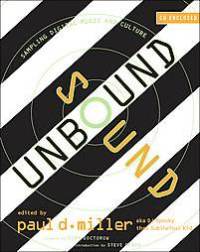Book review: ‘Sound Unbound.Sampling Digital Music and Culture’
 Paul Miller aka DJ Spooky that Subliminal Kid is the pioneer artist of electronic and experimental hip-hop music. Combining jazz, electronica, reggae and various other musical genres, his work has been labeled illbient or trip-hop. From recording sounds made by melting ice in Antarctica to composing music and producing albums, from mastering the art of turn tabling to writing books about the science of sound, DJ Spooky has become known as a ‘world wide expert’, an investigator of sound in all its forms. His new book ‘Sound Unbound. Sampling Digital Music and Culture’, also features writings from other impressive artist like Bryan Eno, Saul Williams and Moby. The book was released this year and it explores the role of sound in the digital media, in an information-based society.
Paul Miller aka DJ Spooky that Subliminal Kid is the pioneer artist of electronic and experimental hip-hop music. Combining jazz, electronica, reggae and various other musical genres, his work has been labeled illbient or trip-hop. From recording sounds made by melting ice in Antarctica to composing music and producing albums, from mastering the art of turn tabling to writing books about the science of sound, DJ Spooky has become known as a ‘world wide expert’, an investigator of sound in all its forms. His new book ‘Sound Unbound. Sampling Digital Music and Culture’, also features writings from other impressive artist like Bryan Eno, Saul Williams and Moby. The book was released this year and it explores the role of sound in the digital media, in an information-based society.
The concept of the book is similar to a big mixtape that meets conversations between 36 authors and about 45 different tracks of collaged, mash up literature and sounds. The sonic mosaic is everything from Aphex Twins to James Joyce, from Bryan Eno to Jean Cocteau and Iggy Pop as well as Sonic Youth, Moby and Chuck D from Public Enemy.
People nowadays are facing the digital media as the creative environment. Thus ‘Sound Unbound’ does not have too much melodic music focus but to a greater extend a mixed media. Sound and recording are presented as contemporary art but moreover the book is about art in general.
In this book Paul Miller tries to explain the phenomenon of coalition between the African music based mostly on percussion sounds and polyphony and the 18th century European classical music that is more melodious. In other words melody and polyphony collided in the United States creating multiple beats. Breaking the boundaries between African and European music was one of the first steps of electronic music and it allowed everyone to look at it as an art.
Many of the book’s contributors talk about the influence and the role of technology in their craft. At this certain point, the tendency is to get rid of the physical objects. Most probably one day, everything will be a wireless weird software. ‘Objects’ are already considered useless. A good example is the ‘community killer’ Mac Iphone – the multi-functional device that can be used to listen music, to write on it, to access the Internet, to take pictures, to order anything anywhere by just clicking a button.
DJ Spooky also explains how music software works in sampling. It is the composer’s tool just as the pen is for the writer. He adds that the best thing about software is that you can have any kind of sound simulation, even a turntable simulation.
One of the main idea in the book is the mash up. Written as a literary mash up – idea sustained through many different essays and interviews- Sound Unbound dubs the different styles of music: hip-hop, techno, drum&bass, rock and so on, ‘the children of the avant-garde’. Creativity is the one that holds it up together.
The joint efforts of the writers gave birth to this marvelous anthology that overlays personal stories and beliefs over one concrete structure, art. Saul Williams wrote an interesting piece about the future of language and compared poetry to a digital code. Jonathan Lethem’s essay is about who owns the memory and about what plagiarism means in the era when everybody has access to information all the time. Some of the writings in the book are interesting pieces on their own but put all together they generate this ‘crazy mix tape’ as Miller likes to say.
As the editor states “I never really think of music as just music. It’s much more than that: like information. It’s a way of holding a mirror up a side to see what’s reflected back.” I feel the same way about music. Sound is information in a different form. And since we live in the super-information era when people are simply over flooded with noise, sounds and music, the loop of perception becomes a relentless hall of mirrors spinning in our minds.